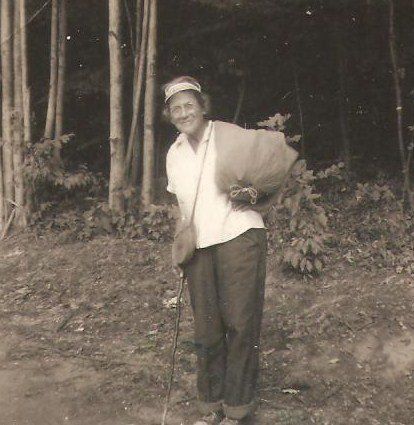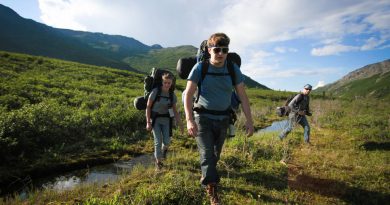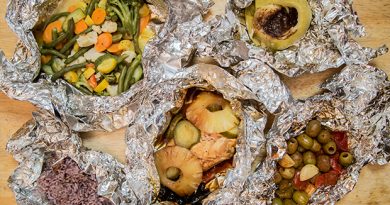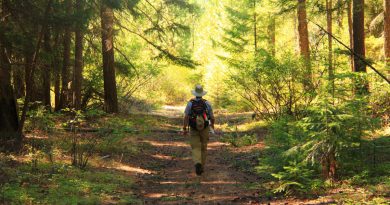The Hike Forever Fitness Plan: Age 65 & Up
Stay in shape with these workout tips, and advice from a fitness hero.
Your Body
True: The effects of aging seem to accelerate after 65. Also true: “Walking and moving around is the single most important thing older people can do to extend their life expectancy and remain independent,” says Bill Evans, of the University of Arkansas’s Institute on Aging. Heft a pack, hit uneven terrain, and the balance and strength gains pile up. Studies have shown that even inactive centenarians can triple their strength after 10 weeks of weight and cardiovascular training. Jump-start your fitness with our workout at the end of this article, then head out on the nearest trail.
A: Brain Mental acuity can wane in the golden years, resulting in slight cognitive impairment colloquially known as “senior moments.” The fix: Walking regularly has been proven to combat mild cognitive impairment and fight depression.

B: Heart The valves that control the direction of blood flow get thicker and stiffer, limiting the amount of time you can spend in the red zone before heart attack becomes a real threat. The Fix: Studies suggest that coenzyme Q10 is effective in reducing heart stiffness, while boosting pumping action and electrical function. Help your body synthesize CoQ10 with wild salmon, sardines, mackerel, and trout.
C: Bones Continued weakening can result in big injuries from small falls. The fix: Fight osteoporosis with calcium (1,000-1,200 milligrams/day) and vitamins D (600 IU per day) and K (80 micrograms per day). Vitamin D aids in calcium absorption, as does sunshine.
Water By age 70, total body water decreases by about 8 percent, which increases the risk of dehydration, heatstroke, and hypothermia. The fix: On trail days, drink half your body weight, in ounces (150 pounds = 75 ounces).
D: Muscle Strength losses accelerate to 30 percent per decade after 65, which can take your trail legs right out from under you–if you don’t use them. The fix: “With strength training, you can regain a decade’s loss in a matter of 6 months,” says Stephen Reichman. Do more reps with less weight, and up your daily protein intake to 1.2 grams per kilogram of body weight.
E: Joints/cartilage/back Wear-and-tear decreases padding in the joints and back, leading to stiffness and pain when hiking. The fix: “Moving a joint loosens it,” Lynn Millar says. At home, guide stiff joints through their full range of motion (arm swings for shoulders; squats for knees) 5 times per day. On the trail, repeat movements in the morning, at rest breaks, and in the evening. Pop 400 milligrams of anti-inflammatories 3 times per day.
F: Skin Your biggest organ thins with age, and your ability to heal wounds decreases. That makes open cuts more susceptible to infection, especially in the backcountry. The fix: Eat zinc (11 milligrams/day), which is found in high concentrations in pumpkin seeds, most nuts, and meat and dairy. If you do get a cut, flush, clean, and treat wounds promptly and thoroughly. And continue to slather on the SPF 40 sunscreen, especially at altitude.
G: Feet Years of use have worn out the padding under your instep and heel, which can create soreness from your feet all the way to your back. The fix: insoles.
Eat Right and Stay in Shape
Eat Right
Your mission is simple: Fight free radicals. These reactive compounds attack cell membranes, red blood cells, and tissue, and they contribute to risk factors for chronic diseases like arthritis, immune dysfunction, Alzheimer’s, atherosclerosis, and cancer. They come from food (especially commercial cooking oils), exposure to UV radiation, and, paradoxically, exercise itself. When the body is young, working out stimulates the production of free-radical-fighting antioxidants within muscle tissue. With age, its ability to produce antioxidants decreases, so you’ll need to get more from your diet. Eat plenty of berries, especially blueberries and blackberries (get ’em trailside!), and pack cherries, cranberries, and goji berries, some of the most powerful antioxidants available.
Age-Defying Digestives
Promote a healthy heart and fight cancer-causing free radicals with this fruity snack high in vitamin A and omega-3 fatty acids.
1 1/2 cup raw cashews, lightly toasted
1 cup raw or crispy macadamia nuts
1/2 cup dried papaya, cut small
1 cup dried mango, cut small
1 cup dried pineapple, cubed
1 cup dried coconut flakes
Longevity
Pose legs up a tree
Older hikers have a harder time moving around for long periods without getting stiff. This pose eases joint pressure and stimulates circulation, which flushes lactic acid and reduces post-hike soreness. How: lay your sleeping pad at the base of a large rock or tree. stand with your shoulder against the boulder while you slide to the ground. Swing your legs around and up the rock. rest here for 5 to 15 minutes, then use your fingers to “rake” your skin from ankle to pelvis. Do 10 rakes.

No Limits
In 1994, the New England Journal of Medicine reported that a group of “very frail” 87-year-olds increased leg strength by 113 percent over 10 weeks with high-intensity strength training every other day.
Double your strength in 10 weeks
“There’s no need to reduce your workouts just because of your age,” says Evelyn O’Neill, manager of exercise services at Hebrew Rehabilitation Center in Boston. Her prescription for maximum strength gains? Do the following exercises every other day in three sets of eight repetitions. Lift six seconds on the way up, three on the way down, resting 1-2 seconds between reps and two minutes between sets. Use 1- to 10-pound ankle weights for all exercises.
1. Seated leg extension From a seated position, slowly extend your right leg until it’s parallel with the ground, then lower. Do three sets of eight reps for each leg.
2. Standing leg curl Stand behind a chair with your legs together. Slowly lift the right foot, bending the knee and moving the right heel toward the glutes. Lower back to the ground. Do three sets of eight reps. Switch sides.
3. Standing hip abduction Stand behind a chair with your legs together. Keeping your toes pointed forward and leg straight, raise your right leg out to the side. Lower it slowly. Do three sets of eight reps, then switch sides.
Trail mix recipes by Esther Cohen (sevenbowls.com)
Yoga poses by Margaret Burns Vap (bigskyyogaretreats.com)

Common Ailment: Cardiopulmonary Disease
You feel fine walking on the flats, but add a pack and an incline and suddenly you’re huffing and puffing or grabbing at your ticker. Stiffening of lung tissue and arteries causes shortness of breath, plus chest and arm pain. For women, ticker trouble manifests itself as pain in the throat following any exertion.
Prevent: Eat a diet filled with monounsaturated fats, including fish oil. These foods promote elasticity in the heart and lung tissues. Kelly advises that new hikers over age 50 (and anyone with risk factors–obesity, family history, previous heart problems) get a stress test prior to a big trip.
Soothe: “Chest pains aren’t like cramps,” says Kelly. “You can’t walk through them. If you feel them, stop hiking immediately and take aspirin. Rest until the pain abates, then hike to safety. Rest and administer rescue meds (aspirin, an inhaler, or prescription heart medication) immediately.
Strengthen: After consulting your doctor, ease into our training program for both cardiovascular and strength gains.
The article was originally seen at https://www.backpacker.com/skills/fitness-special-mdash-hike-forever-age-65-up
Originally posted 2018-03-28 14:59:24.




